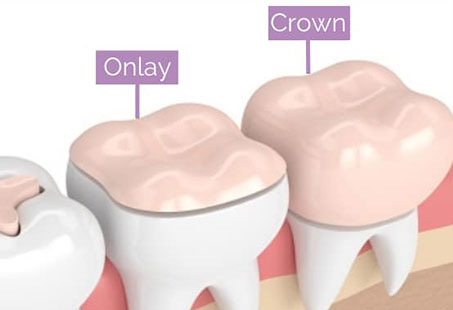Among the different types of dental restorations, the long-standing debate between onlay vs crown continues.
The main difference is that an onlay goes over the cusps of the tooth, and a crown covers the entire tooth.
These structural differences make them more suitable for different circumstances. And that can cause some confusion.
In this guide, you will learn all there is to know about onlays vs crowns, so you can choose the right restoration for you.
What Is A Crown?
A dental crown is an artificial cap that’s fitted over the entire tooth.
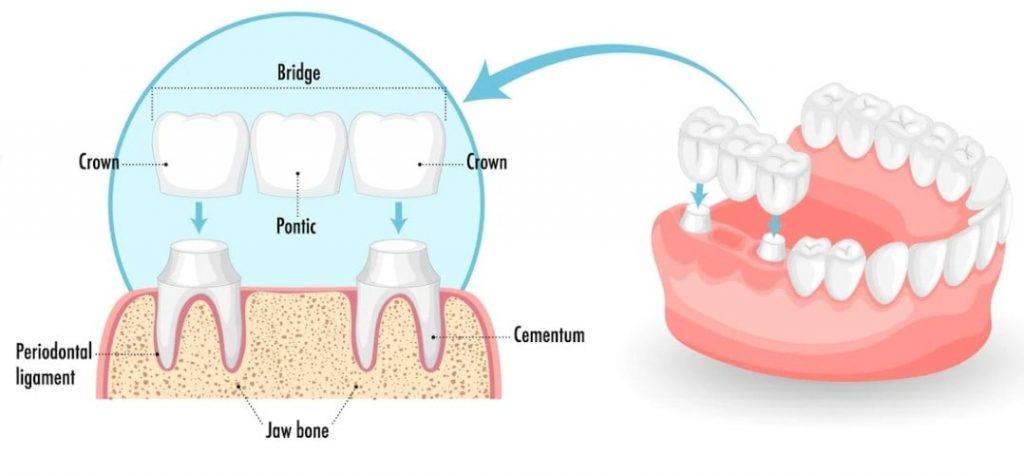
These are made from different materials, including:
- Ceramic
- Resin
- Porcelain
- Metal
- Porcelain fused with metal
These permanent restorations are used for both functional and cosmetic purposes. And since they cover the entire tooth surface, they’re quite durable as well.
Depending on the number of teeth that require restoration, you can get one or multiple crowns (even joined together as bridges).
What Is An Onlay?
A dental onlay is another type of restoration that covers the biting surface of the tooth only.
Unlike a crown, it doesn’t extend all the way to the gum line, and it doesn’t encapsulate the entire tooth.
These restorations on–lay over one or cusps – elevated projections – on the tooth, which can help restore its size and strength.
An onlay is a more conservative treatment option, considered a kind of middle ground between fillings and crowns.
Still, it offers more coverage than an inlay, which only covers the area between the cusps.
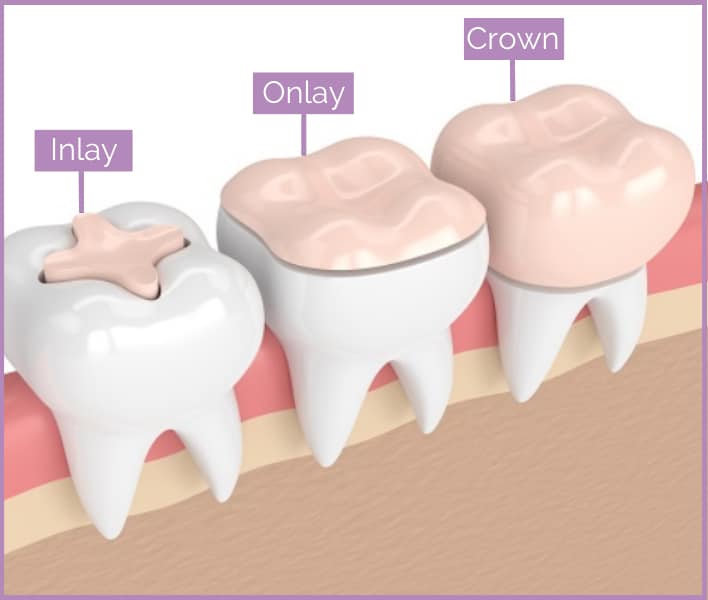
Despite that, there’s a limit to what dental onlays can actually do.
Onlay vs Crown: Where Do They Differ?
Apart from the sizes, onlays and crowns differ in many other ways. Let’s examine them in more detail.
Tooth Preparation
Because of the thickness of the dental crowns, they require more invasive tooth preparation.
According to a study published in the International Journal of Periodontics & Restorative Dentistry, full crowns require 67.5% to 75.6% of tooth structure to be removed. Onlays, however, require only 35.5 to 46.7% of tooth structure to be removed.
For this reason, onlays are considered more conservative since they retain more of the healthy tooth tissue.
Candidates
When the tooth is severely damaged, a crown is preferred over an onlay. That’s because, in that case, a crown can not only protect the tooth but also restore its function more adequately.
Your dentist might recommend a crown in all the following instances:
- Severely broken, cracked or damaged tooth
- Extensive tooth erosion
- Significant tooth wear
- Malocclusion and diastema
- Following endodontic access cavity preparation
- Tooth loss
- Smile makeover
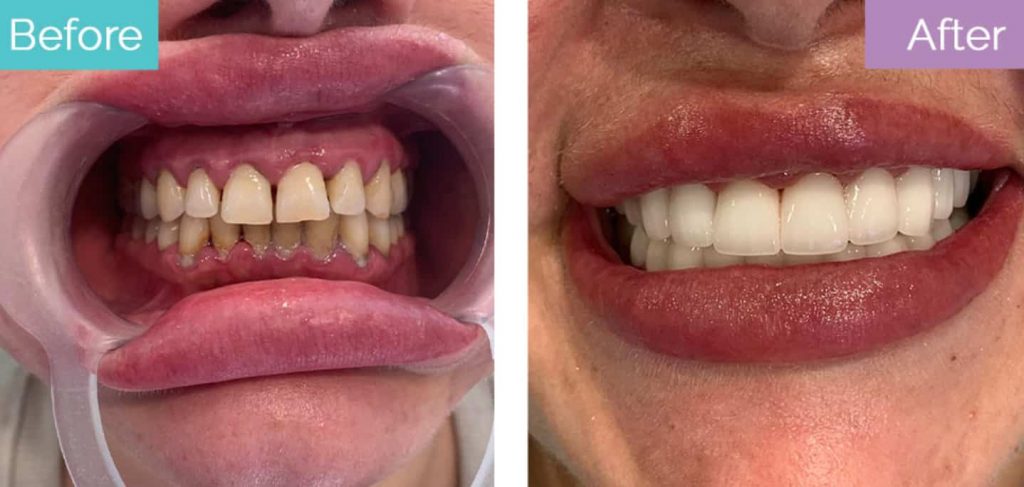
On the other hand, an onlay is usually recommended in the following instances:
- Tooth decay (and inlay or filling is not sufficient)
- Moderate tooth damage
- Conservation of natural tooth
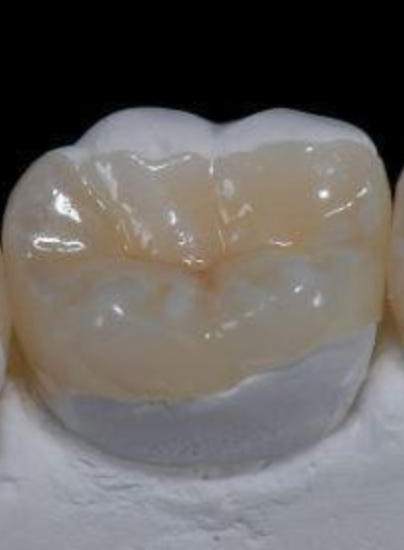
Keep in mind that the difference is the severity of the damage. The more severely the tooth is damaged, the more likely it is that a crown will be better.
According to the American College of Prosthodontists, it’s not easy to determine whether you need an inlay, onlay or crown. It’s important to consult a professional for that.
Procedure
As far as the procedural differences are concerned, it mainly comes down to tooth preparation.
For both crowns and onlays, you’ll be given local anaesthesia. This is so that you don’t feel pain when the tooth is shaved.
In the case of onlays, the decayed, damaged part of the tooth is removed. However, for crowns, the tooth is trimmed to a small stub.
Once that’s done, an impression is made. This is then sent to the lab for the custom preparation of onlay or crown.
While it’s being prepared, you’ll wear temporary restorations. After about a few days, you’ll have a second appointment in which the crown or onlay will be permanently fitted with dental cement.
Longevity
According to a study published in the Journal of Oral Rehabilitation, both types of restorations have a very high survival rate – 93.50% for onlays and 95.38% for crowns.
However, in general, the materials used in onlays and crowns determine their longevity or survival rate.
Additionally, the location of the restoration and the oral/personal habits of the patient also matter in this regard.
Regardless, it’s likely that a dental crown will last longer (5-15 years) than an onlay (5-10 years) because a crown has more structural integrity.
Cost
In the UK, you can get one onlay for around £600 and a dental crown for around £700. In Turkey, one onlay and crown is around £200. However, the price can greatly vary depending on the material.
For instance, in the UK, you can get a full resin crown for around £200. However, a gold crown can cost you as much as £1,000. You can expect the same price variations in onlay prices as well.
Other than that, the extent of the treatment, the location of the clinic, and the experience of the dentist can also impact the overall price of the package.
Just keep in mind that if you go for a cheaper material, it might break more easily. So, it might cost you more in the long run.
Onlay vs Crown: Summary
Here’s a summary of the differences between onlays and crowns:
| Onlays | Crowns | |
| Procedure | The tooth is shaved and an impression is taken. It is sent to the dental lab, which then prepares the only in about a few days. | The tooth is shaved (more extensively) and an impression is taken. It is sent to the dental lab, which then prepares the only in about a few days.. |
| Anaesthesia | Local | Local |
| Candidates | Moderate tooth damage (fillings or inlays can’t be used) with a desire to conserve the natural tooth. | Severe tooth damage, fracture, decay, gaps, discolouration, loss of the tooth or after a root canal. Can also help with misalignment. |
| Number of Appointments | 2-3 | 2-3 |
| Materials Available | Ceramic, metal, composite | Ceramic, porcelain, metal, composite, and fused varieties |
| Longevity | 5-10 years | 5-15 years |
| Cost | Varies according to the material In the UK, around £600/onlay In Turkey, around £200/onlay | Varies according to the material In the UK, around £700/crown In Turkey, around £200/crown |
Conclusion
Onlays and crowns are both useful restorations that have their pros and cons.
Usually, onlays are recommended when either a filling or inlay is not enough to restore a tooth. Additionally, it can conserve more of the healthy tooth.
In contrast, a crown is better suited for those who have severely damaged teeth. While it requires more tooth shaving, it can do a better job of protecting and restoring the teeth.
In any case, it’s important that you make your final decision after consulting with a board-certified dentist. They’ll take your goals and expectations into account before creating a treatment plan.
Reviewed and Approved by Dr Izbel Aksit
